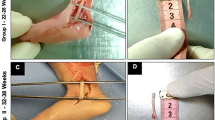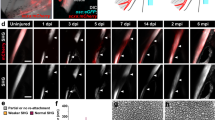Abstract
The aim of the present report is to provide a detailed description of the morphogenesis and initial differentiation of the long tendons of the chick foot, the long autopodial tendons (LAT), from day 6 to day 11 of development. The fine structure of the developing LAT was studied by light and transmission electron microscopy. The characterization by immunofluorescent techniques of the extracellular matrix was performed using laser scanning confocal (tenascin, elastin, fibrillin, emilin, collagen type I, II, III, IV and VI) or routine fluorescence (tenascin, 13F4) microscopy. In addition, cell proliferation in pretendinous blastemas was analyzed by the detection of BrdU incorporation by immunofluorescence. The light microscopic analysis permitted the identification of different stages during LAT morphogenesis. The first stage is the formation of a thick ectoderm-mesenchyme interface along the digital rays, followed by the differentiation of the “mesenchyme lamina”, an extracellular matrix tendon precursor, and ending with the formation and differentiation of the cellular condensation that forms the tendon blastema around this lamina. The immunofluorescence study revealed the presence and arrangement of the different molecules analyzed. Tenascin and collagen type VI are precocious markers of the developing tendons and remain present during the whole process of tendon formation. Collagen type I becomes mainly restricted to the developing tendons from day 7.5. Collagens type II and IV are never detected in the developing tendons, while a faint labeling for collagen type III is first detected at day 7. The analysis of the distribution of the elastic matrix components in the developing tendons is a major contribution of our study. Elastin was detected in the periphery of the tendons from day 8 and also in fibrils anchoring the tendons to the skeletal elements. At the same stage, emilin strongly stains the core of the tendon rods, while fibrillin is detected a little later. Our study indicates the existence of an ectoderm-mesoderm interaction at the first stage of tendon formation. In addition, our results show the different spatial and temporal pattern of distribution of extracellular matrix molecules in developing tendons. Of special importance are the findings concerning the tendinous elastic matrix and its possible role in tendon maturation and stabilization.
Similar content being viewed by others
References
Birk DE, Zycband E (1994) Assembly of the tendon extracellular matrix during development. J Anat 184:457–463
Birk DE, Zycband EI, Winkelmann DA, Trelstad RL (1989) Collagen fibrillogenesis in situ: fibril segments are intermediates in matrix assembly. Proc Natl Acad Sci USA 86:4549–4553
Brand B, Christ B, Jacob HJ (1985) An experimental analysis of the developmental capacities of the distal parts of avian leg buds. Am J Anat 173:321–340
Bressan GM, Daga-Gordini D, Colombatti A, Castellani I, Marigo V, Volpin D (1993) Emilin, a component of elastic fibers preferentially located at the elastin-microfibrils interface. J Cell Biol 121:201–212
Carvalho HE, Neto JL, Taboga SR (1994) Microfibrils: neglected components of pressure-bearing tendons. Ann Anat 176:155–159
Chevallier A, Kieny M, Mauger A (1977) Limb-somite relationship: origin of the limb musculature. J Embryol Exp Morphol 41:245–258
Chiquet M, Fambrough DM (1984) Chick myotendinous antigen. I. A monoclonal antibody as a marker for tendon and muscle morphogenesis. J Cell Biol 98:1926–1936
Christ B, Jacob HJ, Jacob M (1974) Über den Ursprung der Flügelmuskulatur. Experimentelle Untersuchungen mit Wachtel- und Hühnerembryonen. Experientia 30:1446–1448
Christ B, Jacob HJ, Jacob M (1977) Experimental analysis of the origin of the wing musculature in avian embryos. Anat Embryol 150:171–186
Critchlow M, Hinchliffe JR (1994) Immunolocalization of basement membrane components and β1 integrin in the chick wing bud identifies specialized properties of the apical ectodermal ridge. Dev Biol 163:253–269
Curwin SL, Roy RR, Vailas AC (1994) Regional and age variations in growing tendon. J Morphol 221:309–320
Dahlbäck K, Ljungquist A, Löfberg H, Dahlbäck B, Engvall E, Sakai LY (1990) Fibrillin immunoreactive fibers constitute a unique network in the human dermis: immunohistochemical comparison of the distributions of fibrillin, vitronectin, amyloid P component, and orcein stainable structures in normal skin and elastosis. I Invest Dermatol 94:284–291
Davis EC (1994) Immunolocalization of microfibril and microfibril-associated proteins in the subendothelial matrix of the developing mouse aorta. J Cell Sci 107:727–736
Dublet B, Van Der Rest M (1987) Type XII collagen is expressed in embryonic chick tendons. J Biol Chem 262:17724–17728
Fitch JM, Gibney E, Sanderson RD, Mayne R, Linsenmayer TF (1982) Domain and basement membrane specificity of a monoclonal antibody against chicken type IV collagen. J Cell Biol 95:461–467
Fleischmajer R, Perlish JS, Timpl R, Olsen BR (1988) Procollagen intermediates during tendon fibrillogenesis. J Histochem Cytochem 36:1425–1432
Fleischmajer R, Perlish JS, Faraggiana T (1991) Rotary shadowing of collagen monomers, oligomers, and fibrils during tendon fibrillogenesis. J Histochem Cytochem 39:51–58
Greenlee TK Jr, Ross R (1967) The development of the rat flexor digital tendon, a fine structure study. J Ultrastruct Res 18:354–362
Hamburger V, Hamilton HL (1951) A series of normal stages in the development of the chick embryo. J Morphol 88:49–92
Hay E (1991) Collagen and other matrix glycoproteins in embryogenesis. In: Hay ED (ed) Cell biology of the extracellular matrix, 2nd edn. Plenum Press, New York, pp 419–462
Harris AJ, Fitzsimons RB, McEwan JC (1989) Neural control of the sequence of myosin heavy chain isoforms in foetal mammalian muscles. Development 107:751–769
Holder N (1989) Organization of connective tissue patterns by dermal fibroblasts in the regenerating axolotl limb. Development 105:585–593
Hurle JM, Hinchliffe JR, Ros MA, Critchlow MA, Genis-Galvez JM (1989) The extracellular matrix architecture relating to myotendinous pattern formation in the distal part of the developing chick limb: an ultrastructural, histochemical and immunocytochemical analysis. Cell Differ Dev 27:103–120
Hurle JM, Ros MA, Gañan Y, Macias D, Critchlow M, Hinchliffe JR (1990) Experimental analysis of the role of ECM in the patterning of the distal tendons of the developing limb bud. Cell Differ 30:97–108
Hurle JM, Corson G, Daniels K, Reiter R, Sakai LY, Solursh M (1994) Elastin exhibits a distinctive temporal and spatial pattern of distribution in the developing chick limb in association with the establishment of the cartilaginous skeleton. J Cell Sci 107:2623–2324
Keeley FW, Alatawi A (1991) Response of aortic elastin synthesis and accumulation to developing hypertension and the inhibitory effect of colchicine on this response. Lab Invest 64:499–507.
Kielty CM, Cummings C, Whittaker SP, Shuttleworth CA, Grant ME (1991) Isolation and ultrastructural analsyis of microfibrillar struuctures from foetal bovine elastic tissues. Relative abundance and supramolecular architecture of type VI collagen assemblies and fibrillin. J Cell Sci 99:797–807
Kieny M, Chevallier A (1979) Autonomy of tendon development in the embryonic chick wing. J Embryol Exp Morphol 49:153–165
Kieny M, Mauger A (1984) Immunofluorescent localization of extracellular matrix components during muscle morphogenesis. I. In normal chick embryos. J Exp Zool 232:327–341
Kosher RA, Solursh M (1989) Widespread distribution of type II collagen during embryonic chick development. Dev Biol 131:558–566
Linsenmayer TF, Hendrix MJC, Little CD (1979) Production and characterization of a monoclonal antibody to chicken type I collagen. Proc Nat Acad Sci USA 76:3703–3707
Mallein-Gérin F (1990) Subepithelial type II collagen deposition during embryonic limb development. Rouxs Arch Dev Biol 198:363–369
Mallein-Gŕin F, Garrone R (1990) Tendon collagen fibrillogenesis is a multistep assembly process as revealed by quick-freezing and freeze-substitution. Biol Cell 69:9–16
Mecham RP, Heuser JE (1991) The elastic fiber. In: Hay ED (ed) Cell biology of the extracellular matrix, 2nd edn. Plenum Press, New York, pp 79–109
Oliver G, Wehr R, Jenkins NA, Copeland NG, Cheyette BNR, Hartenstein V, Zipursky SL, Grass P (1995) Homeobox gene and connective tissue patterning. Development 121:693–705
Pasquali-Ronchetti I, Baccarini-Conti M, Fornieri C, Mori G, Quaglino D Jr (1993) Structure and composition of the elastic fiber in normal and pathological conditions. Micron 24:75–89
Pautou MP, Hedayat I, Kieny M (1982) The pattern of muscle development in the chick leg. Arch Anat Microsc Morphol Exp 71:193–206
Rong P-M, Ziller C, Pena-Melian A, Le Douarin NM (1987) A monoclonal antibody specific for avian early myogenic cells and differentiated muscle. Dev Biol 122:338–353
Ros MA, Hinchliffe JR, Macias D, Hurle JM, Critchlow M (1991) Extracellular material organization and long tendon formation in the chick leg autopodium. In vivo and in vitro study. In: Hinchliffe JR, Hurle JM, Summerbell D (eds) Developmental patterning of the vertebrate limb. Plenum Press, New York, pp 211–214
Rosenbloom J, Abrams WR, Mecham R (1993) Extracellular matrix. 4. The elastic fiber. FASEB J 7:1208–1218
Ross R, Bornstein P (1969) The elastic fiber. I. The separation and partial characterization of its macromolecular components. J Cell Biol 40:366–381
Sakai LY, Keene D, Engvall E (1986) Fibrillin, a new 350-kD glycoprotein, is a component of extracellular microfibrils. J Cell Biol 103:2499–2509
Scott JE (1984) The periphery of the developing collagen fibril. Quantitative relationships with dermatan sulphate and other surface-associated species. Biochem J 218:229–233
Shellswell GB, Wolpert L (1977) The pattern of muscle and tendon development in the chick wing. In: Ede DA, Hinchliffe JR, Balls M (eds) Vertebrate limb and somite morphogenesis. Cambridge University Press, Cambridge, pp 71–86
Shellswell GB, Bailey AJ, Duance VC, Restall DJ (1980) Has collagen a role in muscle pattern formation in the developing chick wing? I. An immunofluorescence study. J Embryol Exp Morph 60:245–254
Singley CT, Solursh M (1980) The use of tannic acid for ultrastructural visualization of hyaluronic acid. Histochemistry 65:93–102
Slack C, Flint MH, Thompson BM (1984) The effect of tensional load on isolated embryonic chick tendons in organ culture Connect Tissue Res 12:229–247
Sullivan GE (1962) Anatomy and embryology of the wing musculature of the domestic fowl (Gallus). Aust J Zool 10:458–516
Sutcliffe MC, Davidson JM (1990) Effect of static stretching on elastin production by porcine aortic smooth muscle cells. Matrix 10:148–153
Swasdison S, Mayne R (1989) Location of the integrin complex and extracellular matrix molecules at the chicken myotendinous junction. Cell Tissue Res 257:537–543
Tidball JG (1994) Assembly of myotendinous junctions in the chick embryo: deposition of P68 is an early event in myotendinous junction formation. Dev Biol 163:447–456
Tsuzaki M, Yamauchi M, Banes AJ (1993) Tendon collagens: extracellular matrix composition in shear stress and tensile components of flexor tendons. Connet Tissue Res 29:141–152
Vogel KG, Sandy JD, Pogany G, Robbins JR (1994) Aggrecan in bovine tendon. Matrix 14:171–179
Watson SJ, Bekoff A (1990) A kinematic analysis of hindlimb motility in 9- and 10-day-old chick embryos. J Neurobiol 21:651–660
Wortham RA (1948) The development of the muscles and tendons in the lower leg and foot of chick embryos. J Morphol 83:105–148
Author information
Authors and Affiliations
Rights and permissions
About this article
Cite this article
Ros, M.A., Rivero, F.B., Hinchliffe, J.R. et al. Immunohistological and ultrastructural study of the developing tendons of the avian foot. Anat Embryol 192, 483–496 (1995). https://doi.org/10.1007/BF00187179
Accepted:
Issue Date:
DOI: https://doi.org/10.1007/BF00187179




